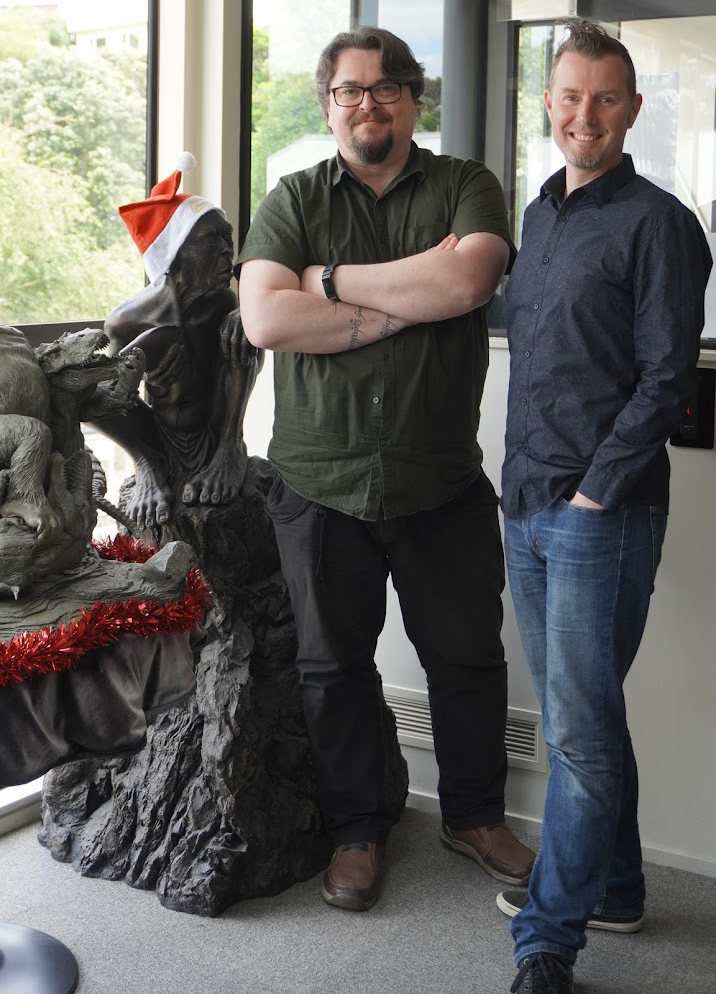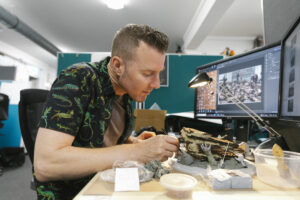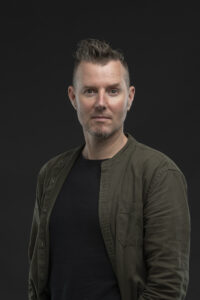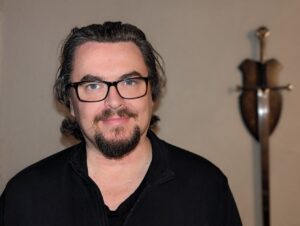We’re delighted to share an exclusive interview from fellow Tolkien fanatic Eirik Bull – a journalist from Norway. He recently sat down with our friend, Weta Workshop’s own Daniel Falconer.
In Eirik’s interview with Daniel they cover a lot of topics, looking at Daniel’s history in working in Tolkien’s amazing world, as seen in Sir Peter Jackson’s brilliant adaptations over 20 years ago. Eirik and our friends at Weta asked us to share this interview – and you can look forward to another interview coming soon, with Sir Richard Taylor. We all hope you enjoy this amazing look at Daniel Falconer’s journey in Middle-earth.

Whether a native of New Zealand or a wanderer from distant shores, journeying through this land often feels like a stroll through the pages of Peter Jackson’s The Lord of the Rings trilogy. The whispering trees and rolling hills seem to hum with tales of heroism and adventure.
Your path may lead you to Queenstown, where the calm waters of Lake Wakatipu reflect tales of yore. Here, amidst the tranquil beauty, enthusiastic tour guides might narrate the stories behind the many scenes from Peter Jackson’s masterpiece, pinpointing where and how they were shot. They might even tell the tale about a certain tree, said to have inspired the creation of Treebeard. Yet, as poetic as it sounds, not all tales are rooted in truth.
I had ventured to New Zealand from Norway on a three-week journey that meandered from Auckland to Christchurch, from Queenstown to Wellington, seeking the whispers of Middle-earth in every leaf and stone. In Wellington, my quest led me to the heart of Wētā Workshop, where I had the privilege of engaging with several of the creative minds who had breathed life into the massive production well over 20 years ago.
Here I met Daniel Falconer, one of the creative minds behind Treebeard’s design, who, by the way, had never laid eyes on that fabled tree. In a room adorned with myriad collectibles and prestigious accolades, including several Academy Awards, we delved into realms of fantasy and craft. With Daniel’s dog by our side, our conversation wandered through the allure of fantasy that kindled Daniel’s imagination growing up, his cherished work on The Lord of the Rings, discussions about a Balrog’s wings, and his dream Middle-earth project.
What inspired your interest in fantasy?
Well, I think being exposed to it as a child played a significant role. I grew up in an area that’s quite forested. I’ve always loved drawing, and my mother was an art teacher, so she would always encourage me to use my imagination. The books I read and the films and television I watched were often in the fantasy or science fiction genres because they sparked my imagination.
I could walk around outside and go for walks in the forest near my home, always excited
about the possibilities. My parents always encouraged that sense of imagination. As a child, you don’t know any different; you just pursue what you love. I feel incredibly fortunate that this interest has turned into a career. The ability to dream and imagine has been an incredible privilege for me. I feel lucky that a place like Wētā exists in my country, allowing me to find my way here. Otherwise, I had always assumed I’d have to go overseas to find opportunities, maybe at companies like the Jim Henson Company or Lucasfilm. These were the places I grew up dreaming about.
When I was around 10 or 11 years old, I remember watching behind-the-scenes documentaries for new movies. Seeing that there was an actual role to be performed, a job to be done in crafting and determining how things look in these films, was eye-opening for me. I thought, “Wow, that’s just what I love doing. Imagine doing that for a career!” So, I’ve sort of been steering in that direction ever since, albeit with a few detours.
You started at Wētā at quite a young age, right? How did that happen?
I was studying illustration and design at the tertiary level, and part of that program involved gaining some practical experience. I was fortunate that, near where I was living in Auckland at the time, they were filming the Hercules and Xena television shows from the 90’s. Through someone we knew, I was able to get some work experience there. That’s where I met Richard Taylor, who runs Wētā Workshop. He was providing creatures for some episodes at the time, so I reached out to him. He was incredibly generous and said, “You should come down and just hang out with us to see if you like it and if this career is for you.” So, I took him up on that offer.
At the age of 21, I flew down to Wellington and spent a week at Wētā, falling in love with the place and the opportunities it offered. In any spare moment I had as a kid, I was drawing creatures, imagining worlds, creating imaginary cultures and characters, or crafting stories set in otherworldly places.
Wētā was a place that did just that, so it was a dream come true. Thankfully, Richard liked me enough to offer me a job. I started around the same time the company began to expand; there were maybe a dozen people before that. We quickly grew to become a much larger company, right around the time just before The Lord of the Rings came along. It was good timing on my part because that was a world I already knew well and loved. I was in the right place at the right time when that project came along a year later.
What kind of work do you do at Wētā now?
The lovely thing about Wētā Workshop is that the company essentially exists as a toolkit for Richard Taylor to use for creating. Richard is just someone who loves making things; he’s a compulsive maker. His mind is always racing, and Wētā allows him to create constantly. We produce a wide range of items, from costumes, creatures and props to live experiences, collectibles, books, and more. There’s always something new happening.
For me, having been at Wētā for 27 years, there’s never been a shortage of new and interesting projects to explore. I initially started out designing for film and television and still do some of that. I’ve also been fortunate enough to work on collectibles, including prop replicas, miniature characters, and environments. Being a collector myself, this is particularly exciting—although it’s dangerous because I want to take everything home!
This work has allowed me to stay involved with Middle-earth, a world I love. Even when there aren’t active film or television projects, I can work on collectibles and keep that legacy alive. I’ve also had the opportunity to write books about Wētā’s work. This has been great because it allows me to engage with my colleagues, learn about their contributions, and share these behind-the-scenes stories with others.
I’ve always been fascinated by the choices made during the creative process. Everything you see on screen is a result of a series of decisions. I enjoy creating art books that delve into these choices and show the designs that were rejected or modified. It offers a look into the “why” behind what you see on screen.
So, there’s always something new and exciting, and it’s been an incredible journey. I pinch myself every day that I get to exercise my imagination and participate in creating these fantastic worlds with amazing filmmakers. I feel incredibly lucky.
Working on The Lord of the Rings must have been anyone’s career highlight, right?
I had always hoped that if I could live my dream and work in the film and television industry, maybe I’d be fortunate enough to be around when The Lord of the Rings was finally made as a live-action film. I always imagined that perhaps it might happen 20 or 30 years into my career, but it ended up being almost the first thing I worked on. Looking back, I wish I had been older when it happened so that I could have brought more experience and fully appreciated how special it was.
The upside of being so young and inexperienced was that neither I nor my colleagues fully grasped the enormity of what we were doing. As a result, we weren’t paralyzed by fear, which might be the case for me now. It’s incredibly daunting to adapt such beautifully written and thoroughly realized books for the screen. We were fortunate to be naive and just started working, doing the best we could. Perhaps that naivety enabled us to actually go through with it.
How was the response in New Zealand and in the fandom in general when you said that you were going to make these movies?
Initially, there was a lot of skepticism and concern, which is completely understandable given how much these stories mean to people, me included. The idea of adapting such cherished material for the screen can forever alter how people perceive the original stories. Some people will experience the films before the books, and their imagination will inevitably be influenced by what they’ve seen on screen. So yes, there’s a tremendous responsibility, and that elicits fear. I even had that internal dialogue myself: “What if it’s terrible? What if we ruin it?”
But then, there’s also the excitement and the possibilities. The thought of, “What if it’s great? And what if we get to be a part of something amazing?” I think having years of uncertainty about the project ended up being beneficial. Even though pre-production wasn’t officially green-lit until we’d been working on it for two years, that period gave us time to prepare, understand the world better, and get organized. Looking back, I think that time was crucial; without it, the outcome might have been different.
What was the most challenging part of creating this world for the screen?
The early stages were particularly challenging because we had to define what Peter Jackson’s Middle-earth would look like, based solely on the books, the scripts, and Peter’s own vision. We had an entire world to conceptualize without any existing design boundaries. So initially, the toughest part was figuring out the aesthetic limitations of this world—what belongs and what doesn’t.
For instance, when we started designing the Uruk-hai, we were essentially writing the rulebook not just for them but for the entire world’s aesthetic. Questions like, “What does armor look like in Middle-earth” or “Where on the scale between high realism and high fantasy does this world lie?” were being asked and answered in real-time. When Peter said “no” to a design, it helped us understand the boundaries as much as when he said “yes.” So, the early phase was a process of trial and error that was both tough and enlightening.
As we progressed, the design process became more streamlined. The more designs Peter approved, the better we understood the world’s aesthetic. So, if I had to sketch a sword later in the project, I knew exactly what it should look like, as opposed to just having a range of possibilities.
Peter’s direction to look at historical epics rather than high fantasy films for inspiration was also helpful. Each culture and character in the story had its own spot on the realism-to- fantasy spectrum. For example, the Ents are more fantastical, while the Rohirrim are grounded in something closer to our own history. Balancing these different tones and influences was challenging but incredibly rewarding.
Yes, you can see buildings very much like Edoras in museums back home in Norway, for example.
Here we had the benefit of people like Alan Lee and John Howe, who are not only tremendous illustrators and designers but also learned historians in their own right thanks to decades of studying Tolkien and his sources. They can reach back into our own history and pull things that have credibility and reality to them. And they’re looking at the same things that Tolkien was looking at when he was inspired. So, there’s an authenticity to it.
I think it would have been different if we didn’t have John and Alan. It would have been different because none of us, the much younger crew who worked on the project, had that same level of education or experience. We were simply too young to know that stuff yet.
So, we were coming at it thinking, “Well, what did we play? Dungeons & Dragons in high school.” We started drawing stuff that we imagined in those worlds. And it’s different. It’s very different. You don’t have that same grounding in reality.
That’s one of the reasons why it works so well in the films—there’s a level of groundedness, a sense that, “Oh, this feels like a believable place.” It’s not all just fantastical. Everything you see has a reason for being, and that has been thought out.
Why do you think The Lord of the Rings resonates so much with people?
The source material is key to begin with. I think what Tolkien wrote is timeless. The world he created is unparalleled in terms of how rich and deep it is. And I’m not throwing shade at other creators. I mean, here I am, 26 years later, still reading those books and finding more depth in them. You can just keep digging down and there’s more and more to be found. I also think the characters he created resonate with people because there are connections there that you can make. But the richness of the world is what I fell in love with.
I’m incredibly grateful that the films have been well received because we all poured ourselves into them. We really threw everything at it. We put it all in there. But again, those films would not be successful if it weren’t for the fact that they were built on an incredibly firm foundation of this fantastic story, these wonderful characters, and this amazing world.
And I think all of us who worked on it did our absolute best to try and make sure that we maintained that integrity and that we referenced that material again. You know, when you’re dreaming up things to be in the film, sometimes you come across subjects that weren’t in the books. We always tried to do that as thoughtfully as possible. And we asked ourselves: “What would Tolkien have done?” or “What are the things that inspired Tolkien that we can reference to try and keep it authentic?”
There’s a big discussion in the fandom, and I’m sure you’re aware of it. The Balrog: wings or no wings?
I believe Tolkien describes “a shadow, like vast wings”. It has been a while since I’ve read that specific passage and don’t recall the conversations that we had around it at the time we were designing for the film, so I can’t speak to how we got to where we did, but in the final scene, we had “finger-like shapes” with a sort of smoke between them, which creates the suggestion of wings. I mean, he’s a spiritual being, right? That suggests to me that the creature could perhaps manifest differently depending on the situation. So, there’s a degree of interpretation there.
I think Peter Jackson chose to interpret the concept of wings more literally than figuratively in the film. I don’t know that I have a strong feeling about that. Tolkien’s writing is often more suggestive than definitive. It’s interesting that the Balrog falls and yet can’t arrest his fall, despite the implication of wings. But there are different kinds of flight—there’s gliding, there’s lifting. I think there are all kinds of different ways to interpret that. I don’t see a contradiction, personally.
I don’t know if there’s a correct answer because Tolkien doesn’t define everything. Personally, I don’t mind that ambiguity. I think sometimes it gives us room to interpret and imagine for ourselves. With some of those liminal creatures, like the Balrog, that are more spiritual than physical, the answer could be both or neither. I’m fine with that.
If you could adapt any Tolkien or Middle-earth project, what would it be?
The Silmarillion! Of course, it would be The Silmarillion. Can you imagine it? The Silmarillion as a series of well-funded, huge movies, or even a television show? My goodness! I mean, I love The Lord of the Rings, but I adore The Silmarillion. There’s something about the tragedy of so many of those stories that really excites me. And the language is just so evocative. I’m not exactly sure why, but it captivates me.
I go back and read it all the time. I would love to break it up and do it as a series of films. For instance, you could have a film that’s just the story of Beren and Luthien, or one that focuses on the story of Túrin Turambar. You could cover the Fall of Gondolin or even the Akallabêth. Each of these stories deserves its own singular focus but could also be linked together to form one overarching narrative. I would love to see something like that. It would be amazing.
I would love to see that. I think it’s fantastic that we can sit here, well over two decades after these movies were made, and just geek out about them.
They’re timeless and relevant as ever. Isn’t that amazing? I’m forever grateful for what that experience did for me and that I can be linked, in some small way, with the genius of J.R.R. Tolkien.
About our friend Eirik Bull who conducted this wonderful interview:
Eirik Bull is a Norwegian film journalist, screenwriter, and wannabe producer who regularly contributes to websites like Norway’s Filmmagasinet.no and Denmark’s Moovy.dk, specializing in science fiction, fantasy, and fandom-related franchises. Eirik has penned numerous articles on the psychology and sociology of media fandom, and often appears in Norwegian media and podcasts to discuss these topics. He is also a member of the International Federation of Film Critics (FIPRESCI), The Norwegian Film Academy, and a voter in the Golden Globe Awards.





